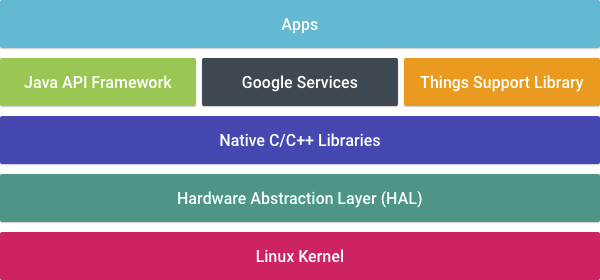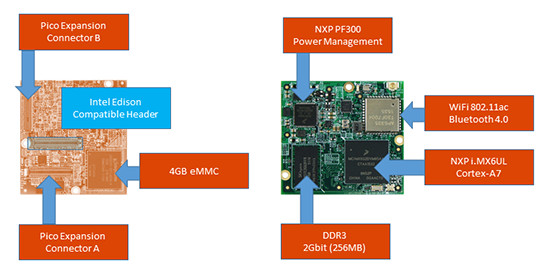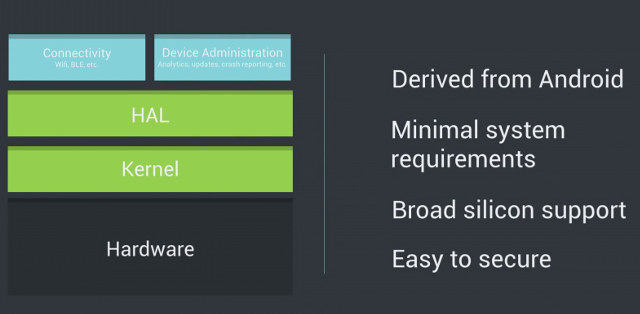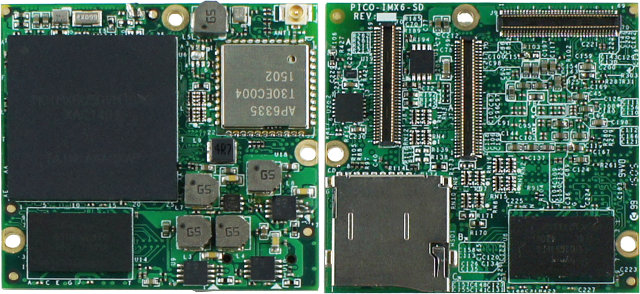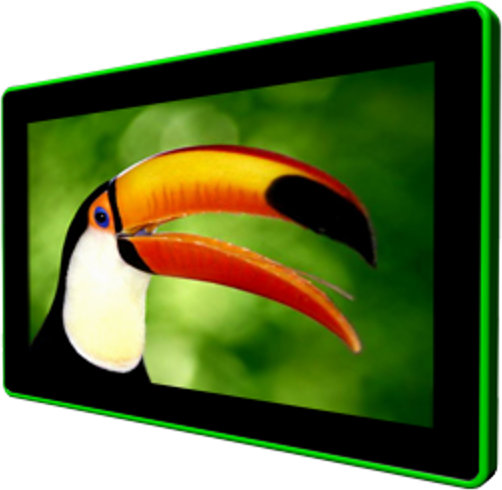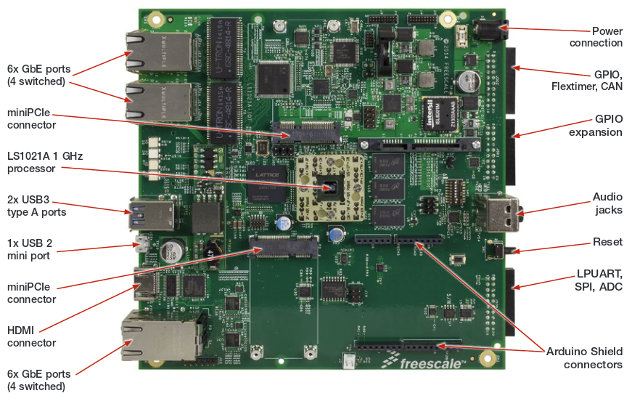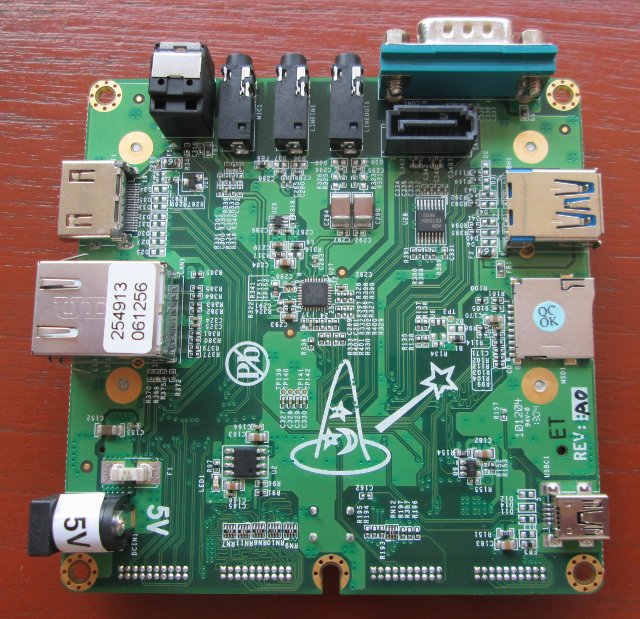Google introduced Project Brillo a little over a year ago, an operating system based on Android, but with a smaller footprint optimized for Internet of Things applications. Brillo has now just become Android Things OS, with Google releasing a developer preview of Android Things working on Raspberry Pi 3, Intel Edison, and NXP Pico boards. The company has also updated the Weave platform to simplify connection of all types of devices to the cloud, and interaction with services like the Google Assistant. The Weave Device SDK currently supports schemas for light bulbs, smart plugs, switches, and thermostats, with more type of device supported in the future, as well as a mobile app API for both Android and iOS. Using an Android based OS instead of a pure Linux OS should make it easier for Android app developers to create smart devices thanks to the use of familiar Android APIs and […]
Wandboard Introduces $69 Hobbitboard Made for Brillo Powered by NXP i.MX6 UltraLite Processor
Wandboard was one of the first to launch boards based on Freescale i.MX6 Solo, Dual and Quad in early 2013. The boards are comprise of an EDM system-on-module and a carrierboard, that makes it not only suitable as a single board computer, but you could also use the boards to start developing software, while making your own carrierboard to match your application. Wandboard.org community sent me an email last night to let me know about their latest board called Hobbitboard, or in full “Hobbitboard Made for Brillo”, powered by NXP i.MX6 UltraLite Cortex A7 processor, which follows the same principle, and includes Hobbit Compute Module and Hobbit I/O Carrierboard. Hobbit Compute Module specifications: SoC – NXP i.MX6 UltraLite Cortex A7 processor @ 528 MHz System Memory – 256MB DDR3 Storage – 4GB eMMC flash Connectivity – 802.11ac WiFi and Bluetooth 4.0 (Ampak AP6335) Board Connectors – Two Pico Expansion header […]
Brillo Android based OS for IoT Projects Supports ARM, Intel and MIPS Platforms
You’d think there are already enough lightweight operating systems that could provide a good enough platform for IoT and embedded projects, but Google decided to make their own Brillo operating system for IoT, based on Android, most probably to leverage the existing Android tools, and make it easier for app developers to move to the Internet of Things space. Brillo ‘s hardware requirements are pretty low as the operating system can run on devices with 32MB of RAM, and 128MB of storage. Google will provide a complete ecosystem with an embedded OS, core services, and a developer kit with tools to build, test, and debug. Just like in Android, three architectures will be be officially supports, starting with the following hardware platforms: ARM – TechNexion Pico-i.MX6UL system-on-module based on Freescale i.MX6 UltraLite and Broadcom BCM4339 802.11ac + Bluetooth 4.0 wireless module, combined with PICO-DWARF baseboard. MIPS – Upcoming MIPS Creator […]
TechNexion Introduces Intel Edison Compatible PICO-iMX6 SoM and DWARF Board
Intel Edison is a board made for wearables featuring an SoC with Intel Atom and Quark CPU cores. TechNexion, an embedded systems company based in Taiwan, has decided to make a mechanically and electrically compatible system-on-module featuring Frescale i.MX6 Solo or Duallite ARM Cortex A9 processor called PICO-iMX6. The company is also providing a PICO-DWARF baseboard that’s both compatible with PICO-iMX6 SoM and Edison board. DWARF stands for “Drones, Wearables, Appliances, Robotics and Fun”, so that pretty much explains what the platform is for. PICO-iMX6 System-on-Module Two version of the modules are available: PICO-iMX6-SD and PICO-iMX6-EMMC, the former with a micro SD slot for storage, and the latter a 4GB eMMC. Both share the followings specifications: SoC – Freescale i.MX6 Solo / Duallite single/dual core ARM Cortex A9 @ 1Ghz with Vivante GC880 3D GPU and Vivante GC320 2D GPU (Composition) System Memory – 512MB or 1GB DDR3 Storage – […]
Toucan-0700 HMI Panel Runs Linux or Android on Freescale i.MX6 Processors
TechNexion Toucan-0700 is an HMI (Human Machine Interface) panel based on Freescale i.MX6 modules and a baseboard following EDM standard for system-on-modules. The 7″ panel PC features the same EDM1-CF-IMX6 SoM used in Wandboard development boards, and runs various Linux distributions, as well as Android 4.3 or 4.4. Toucan-0700 specifications: SoC – Freescale i.MX6 Solo/Duallite Cortex A9 processor with Vivante GPUs (i.MX6 Dual/Quad on request) System Memory – 512MB (Solo), 1GB (Duallite) Storage – 4GB eMMC + micro SD slot Display – 7″ LCD display with LED backlight, 1024×600 resolution; 16M colors; 500 cd/m²; 4 points touchscreen Video Output – HDMI 1.4 for external display Connectivity – Gigabit Ethernet with POE function 802.3at, and optional WiFi 802.11 b/g/n + Bluetooth 4.0 (Broadcom BCM4330) USB – 1x USB 2.0 host port, 1x USB OTG 3.0 connector, 2x internal pin headers Serial – 1x RS-232 (galvanic isolated), 1x RS-232/422/485 (galvanic isolated), 2x […]
Linux 3.18 Released
Linus Torvalds released Linux Kernel 3.18 last Sunday: It’s been a quiet week, and the patch from rc7 is tiny, so 3.18 is out. I’d love to say that we’ve figured out the problem that plagues 3.17 for a couple of people, but we haven’t. At the same time, there’s absolutely no point in having everybody else twiddling their thumbs when a couple of people are actively trying to bisect an older issue, so holding up the release just didn’t make sense. Especially since that would just have then held things up entirely over the holiday break. So the merge window for 3.19 is open, and DaveJ will hopefully get his bisection done (or at least narrow things down sufficiently that we have that “Ahaa” moment) over the next week. But in solidarity with Dave (and to make my life easier too 😉 let’s try to avoid introducing any _new_ […]
Freescale LS1021A-IOT IoT Gateway Reference Design Powered by QorIQ LS1021A Dual ARM Cortex A7 SoC
Freescale has just launched a an IoT gateway reference design powered by their QorIQ LS1021A communication processors running Linux/OpenWRT, designed in partnership with TechNexion, and targeting various IoT applications such as building/home management, smart cities, networked industrial services, etc… Beside the dual core Cortex A7 QoirIQ processor, the board features six Gigabit Ethernet ports, two USB 3.0 ports, a SATA 3 port, two mini PCIe connector, an LVDS interface, HDMI output, Arduino UNO compatible headers, and various others expansions headers. LS1021A-IOT IoT gateway Specifications: SoC – Freescale QorIQ LS1021A dual core Cortex A7 communication processor @ 1 GHz (5,000 coremarks) MCU – Freescale Kinetis K20 Cortex M micro-controller System Memory – 1 GB DDR3L Storage – 1 Gb QSPI NOR Flash, SDHC slot (up to 32 GB) populated with a 4GB SD card, 1x mSATA 3 slot Connectivity – 6x Gigabit ports via SGMII (Serial Gigabit Media Independent Interface) and […]
Wandboard Releases Updated Android and Ubuntu Linux Images and Source Code
Since I’ve received my previous short review of the Wandboard Dual development board, there has been more work on done the platform with new Android and Ubuntu images, Jelly Bean source, Linux SDK release, and git repo setup. I’ve tried the binary images, and had a quick look at the source code and corresponding documentation. Android 4.1.2 Image and Source Code Wanboard has release an improved Android image on the 14th of March which you can download for both Solo and Dual version of the development board with the following Changelog: Fix HDMI audio/playback issue with certain monitor. Add support for wifi on wandboard-dual. Known issue: Might need to turn off “Avoid poor connections” in Wi-Fi ->Advanced to keep connection alive. I’ve given it a try in Wandboard Dual, and it seems Ethernet support is gone (Sorry my mistake, Ethernet IS working, but there’s no indication when it’s connected, and […]


